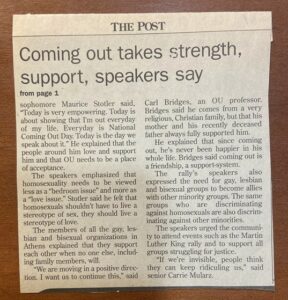By Maggie Bennink, History and Classical Civilizations ’24, Mahn Center Fall 2022 Intern
As an intern for the Mahn Center, I was able to process an entirely new collection of materials that was donated this past summer. Initially, this prospect was daunting, as I had no experience doing archival work. The collection is also fairly large, which adds to the intimidation I felt when starting this project. Ultimately, I found that the materials created a narrative, weaving together many small details to record what life was like at Ohio University during the 1980s and 90s for the LGBT community.
The collection is made up of club records, administrative documents, posters, informative pamphlets, a few magazines, and lots of newspaper clippings. The club records include meeting minutes, club newsletters, and their constitutions. There are also emails and other communication between the clubs and the administration at Ohio University. Since a primary function of these clubs was to put on inclusive events, the collection also holds the many stages of planning and promoting their club activities.
One of the most prominent clubs that met on campus in the 1990s was Open Doors. This club does not still exist today, but when they did, they held large events that were geared towards queer students who felt as though they had not been able to express themselves before coming to college. The photo below shows a flyer for their “Snow Ball,” a dance which allowed students the opportunity to live out their dreams of going to prom or homecoming with their preferred partner. It was open for anyone, but was tailored for young members of the LGBT community.

The LGBT collection also includes many administrative documents from Athens City Council and the Ohio University Student Senate. These documents range from communication between the University President’s office and student organizations, to official city ordinances promoting the inclusion of LGBT peoples in Athens. The image below is of an amendment to the Athens City Code of Ordinances, in which they change the definition of discrimination of people in employment settings to include “sexual orientation.” In other words, this means that employers could no longer discriminate against people based on who they love – which, unfortunately, is still an issue to this day.

There are also a ton of newspaper clippings, which show a timeline of the struggle for equal rights at Ohio University and in Athens. There are some articles from local newspapers that talk about national LGBT events: marches for equal rights, the exclusion of queer people from the United States military, and the inclusion of early queer icons in pop culture. The image below is from the Post, the Ohio University newspaper. Unfortunately, the article is not complete, and is not dated, but since it is talking about Ohio University’s “Coming Out Day” celebrations, I believe it was released in the mid-1990s.

Coming Out Day was celebrated nationally, and still is, but was celebrated at Ohio University mainly in the 1990s. It is celebrated on October 11th, beginning in 1988. The LGBT Collection holds many event posters and brochures about this celebration on campus. Ohio University LGBT clubs, specifically Open Doors, held events with the theme of celebrating one’s identity. There were religious events, with speakers who spoke about their experience coming out queer as a Christian or Jewish person. There were also fun events, such as lunches and cookouts, which allowed people from the LGBT community at Ohio University to mingle with one another in an environment catered just for them. Below is a poster promoting what I believe to be the first Coming Out Day celebratory event held at Ohio University, from 1991.

If I had to pick one piece that stood out to me from the entire collection, I would choose this poster (below) from the late 1990s, from a club called Swarm of Dykes (SOD). This club was for people who identified as lesbian, or were open to helping fight to take back the word “dyke,” which was often used in a dergoatory sense. The poster itself says “SOD, dyke mafia,” which, upon looking at the other materials from this folder, is exactly what the club marketed themselves to be. Those involved in the Swarm of Dykes were outspoken about their sexual identity, or, at the very least, were strong allies. Swarm of Dykes was one of the more proactive clubs on campus, as they swore to protect those who did not feel comfortable publicly presenting their sexuality.

Being able to process this collection was an incredibly meaningful experience to me, as it affirmed that I am welcome on campus as a queer person myself. Overall, it showcases a truly special part of Ohio University’s queer history, and I hope that people will be able to connect with the materials in the collection as I have.
To see more of the collection and learn more about this internship, check out the lgbt_archives_ou Instagram, and the digital collection.